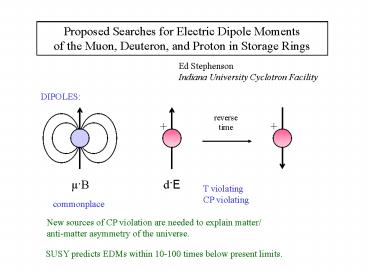Proposed Searches for Electric Dipole Moments - PowerPoint PPT Presentation
1 / 9
Title:
Proposed Searches for Electric Dipole Moments
Description:
Proposed Searches for Electric Dipole Moments. of the Muon, ... good when anomalous moment is small ( , d) a = -0.143. For the deuteron, ?a ?cyc and spin lags ... – PowerPoint PPT presentation
Number of Views:27
Avg rating:3.0/5.0
Title: Proposed Searches for Electric Dipole Moments
1
Proposed Searches for Electric Dipole Moments of
the Muon, Deuteron, and Proton in Storage Rings
Ed Stephenson Indiana University Cyclotron
Facility
DIPOLES
reverse time
?
?
µ?B
d?E
T violating CP violating
commonplace
New sources of CP violation are needed to explain
matter/ anti-matter asymmetry of the universe.
SUSY predicts EDMs within 10-100 times below
present limits.
2
Present limits
neutron lt 6.3 10-26 e?cm electron (Tl atom)
lt 1.6 10-27 e?cm atom (199Hg) lt 2.1 10-28
e?cm screening reduces to 4 10-25 e?cm on
neutron
Usual method place in E field, measure
precession rate
Why build a storage ring?
electric field at particle (v x B) 10-100 time
stronger than lab fields
can open search to charged particles
different systematic errors from trap/box searches
Issues
experiment still hard
costly compared to trap searches
3
What is the signal?
an EDM will cause spin to precess out of ring
plane vertical polarization rises with time
first polarize particle along momentum
radial E field
but there is a problem
the µ?B precesses the spin quickly in the ring
plane
B
(together the precession plane tilts, but this is
hard to observe)
4
Method 1
good when anomalous moment is small (µ, d)
For the deuteron, ?a lt ?cyc and spin lags behind
revolution around the ring.
a -0.143
5
Method 1
good when anomalous moment is small (µ, d)
In all the bending magnets, place an outward E
field to expand the size of the orbit.
This lengthens the time for the
particle to complete a revolution
while keeping the B field the
same. The right ratio of B and
E makes ?a ?cyc.
a -0.143
p 0.7 GeV/c (126 MeV) E 3.5 MV/m B 0.21
T radius 13.3 m
6
Method 2
good for a broad class of charged particles
Put 2 RF cavities in the ring so that the
velocity is changed twice on each turn
around the ring (synchrotron oscillation).
imagine a 1
fast
?sync ?a
Vertical polarization accumulates in opposite
ways on opposite sides of the ring. But
speed change means it does not cancel.
E
E
slow
py
for protons, operate at ?sync ?a - 2
time
7
EDM polarimeter
- IDEA
- make thick target defining aperture
- scatter into it with thin target
lost to ring acceptance (2 kb)
40 MeV 10-5 1 GeV 6x10-4
cross section
(POMME efficiency several percent)
detector system
Coulomb
useful for spin (17 mb)
nuclear
U
defining aperture primary target
angle
L
extraction target - gas
R
D
R
?
D
Target could be Ar gas (higher Z).
Detector is far enough away that
doughnut illumination is not an acceptance
issue ? lt R.
Hole is large compared to beam. Every- thing
that goes through hole stays in the ring. (It
may take several orbits to stop scattered particle
.)
Events must imbed far enough from hole to not
multiple scatter out of primary target, thus ? ltlt
D. ?, which is a large fraction of the deuteron
range, sets scale for polarimeter.
Target extracts by Coulomb scattering
deuterons onto thick main target. Theres not
enough good events here to warrant detectors.
Primary target may need to be iris to allow
adjustment of position and inner radius. It may
also need to be removed during injection.
8
Challenges
systematic contribution from Br at particle
closed orbit cancels Br on average (lab frame)
Method 1 Tilted E field produces Br from v x
E. Cancel by repeating
experiment CCW vs. CW. (limits sensitivity
to 10-27 e?cm for deuteron)
Method 2 Can come from RF cavity (out of phase
and off axis), sample with
different vertical tunes
polarization coherence time
longitudinal orientation is unstable equilibrium,
so reduce perturbations with field corrections
Method 2 phase space coherence time
reduce perturbations
9
Prospects
designs look feasible for p, d, and possibly
3He excellent sensitivity to EDMs on quarks or in
NN interaction
sensitivity limits are (roughly) 10-27 e?cm in
Method 1 10-29 e?cm in Method 2 (running time
about 4 months with spin coherence time 20 s)
all systematic errors checked so far are
manageable
Plans
continue ring designs, systematic error
investigations
do polarimeter RD (deuteron at KVI, Groningen)
gather material for a proposal































